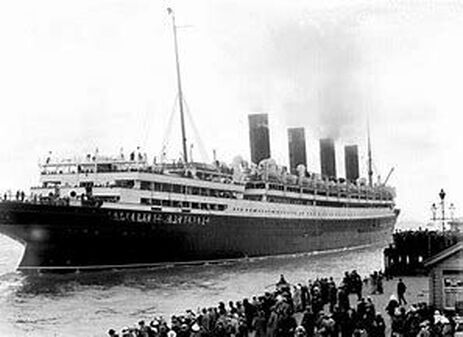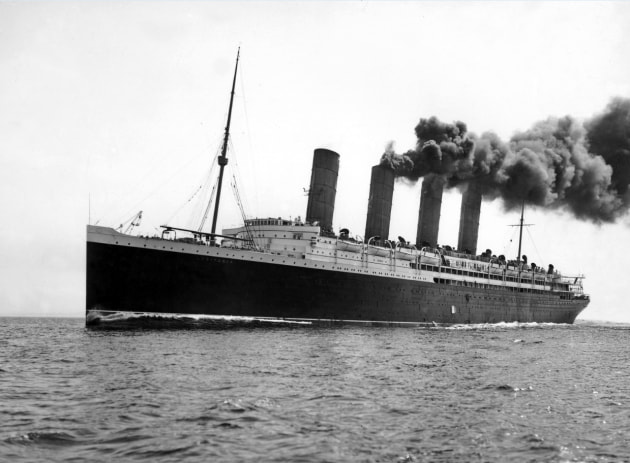Lusitania home page
SUMMARY Like Titanic, Lusitania is primarily remembered for her demise. Her sinking by a German U-boat was an important factor leading to the United States' entry into World War I. However, Lusitania also deserved to be remembered for her achievements during her service life. A Blue Ribband holder, she was the first ocean liner to cross the Atlantic in less than five days. She was also briefly the world's largest ship until her sister ship Mauretania entered service. In addition, her technological innovations rendered all existing ocean liners obsolete when she entered service in 1907.
As 20th century began, the completive situation on the Atlantic was deteriorating for the British. American financer J.P. Morgan was buying up shipping companies in order to create a monopoly. Furthermore, the newest and grandest ships on the Atlantic service flew the flag of Britain's arch-rival Germany. Cunard Line, the last major independent British line, wanted to build new completive ships but it did not have the money. Therefore, the British government stepped in and loaned Cunard 2.5 million pounds sterling in order to build two new fast ships. Cunard agreed that it would remain an independent British company and that, in the event of war, the two ships could be requisitioned by the Admiralty. Although Lusitania and Mauretania were sister ships, they were not identical. Lusitania was built in Scotland by John Brown & Company while Mauretania was built by Swan Hunter in England. Cunard had extended the shipyards some discretion in designing and building the two ships which resulted in differences between the ships. The most visible of these was the ventilators, which were flat topped on Lusitania and rounded on Mauretania. Mauretania was also somewhat longer and heavier than Lusitania. The proposed new ship was so large that John Brown & Co. had to build a new slipway in which to construct her. The shipbuilder started laying the keel for Lusitania on August 17, 1904 and she was launched nearly two years later on June 7, 1906. Lusitania undertook a series of sea trials in July 1907 during which she achieved speeds of over 26 knots. However, at full speed the aft end of the ship suffered from such severe vibration as to make the second and third class areas almost uninhabitable. After the trials, John Brown & Co. made alterations in an effort to solve the vibration problem but vibration at high speed continued to plague the ship into her career. Lusitania was delivered to Cunard on August 26, 1907. Her maiden voyage from Liverpool to New York with a stop at Queenstown, began September 6. When the ship arrived in New York on September 13, thousands turned out to welcome her. Lusitania was viewed as a technological marvel and the height of luxurious living. It had been widely anticipated that the ship would break the Atlantic speed record on her first voyage but fog delayed the ship and she failed to capture the record by a half hour. Her return voyage was also delayed by fog. However, on her third voyage, she captured the Blue Ribband. She would continue to hold the record until her sister entered service some three months later. (Lusitania briefly recaptured the record in July 1909 after being fitted out with new propellers but Mauretania quickly snatched it back). During her service career, Lusitania made 201 transatlantic crossings. Most of these were uneventful. However, in January 1910, the ship encountered a 75 foot high rogue wave. Designed to cut her way through the waves, Lusitania punched through the rogue. However, there was some damage to the ship. When Britain entered World War I in 1914, Lusitania and Mauretania were subject to being requisitioned by the Admiralty. The loan agreement between Cunard and the British government envisioned that the ships would be used as armed merchant cruisers (raiders). However, the Admiralty quickly decided that the ships were not suited for that purpose. It requisitioned Mauretania for use as a hospital or troop ship but left Lusitania with Cunard. The demand for transatlantic travel dropped with war raging in Europe and so Lusitania's schedule was reduced to a monthly schedule. In addition, to cut costs, Cunard closed one of the ship's boiler rooms, which also reduced Lusitania's top speed. On May 2, 1915, Lusitania departed New York's Pier 54 for her 202nd crossing. While sailing past the southern coast of Ireland, Lusitania was torpedoed by U-20. The liner sank in 18 minutes. 1,198 people including 128 Americans were killed. The sinking of such a famous civilian ship shocked America and although America did not enter the war immediately, the stage was set for her to do so. (See our article “Lusitania's Last Voyage” (below) for a more detailed account). |
Above : Lusitania is launched June 7, 1906.
Above: The First class dining salon.
Below: Lusitania's triumphant entry into New York harbor. |
ESSENTIAL STATISTICSTHE BASICS
CLASS: Lusitania class BUILDER: John Brown & Co. (Scotland) REGISTRY: British ENTERED SERVICE: 1907 LINE: Cunard Line SIZE TONNAGE: 31,550 gross tons LENGTH: 787 feet BEAM: 87 feet DRAFT: 34 feet PEOPLE PASSENGERS: 2,165 (563 first class) (464 second class) (1138 third class) CREW: 892 OFFICERS: British TECHNICAL: MAXIMUM SPEED: 26.7 knots SERVICE SPEED: 25 knots POWER PLANT: Steam turbines PROPULSION: 4 propellers STABILIZERS: No |
Above: Lusitania in New York City.
Below: All that remains of the Cunard pier today is the front entrance arch. |
FEATURE ARTICLES
|
Luistania's Last Voyage - Article on the sinking of the Lusitania.
Cobh, Titanic and Lusitania - Article tells of the roles the small town of Cobh, Ireland played two of the worst maritime disasters.
|
Profile - Historic ship (Cunard Line) - Lusitania










